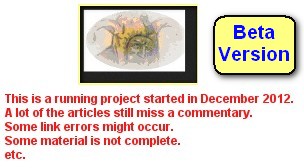Antonio di Dino (Canacci), supplier of cards for silk dealers and Lapini family
composed by Lothar Teikemeier, last updated 06.12.2012
First recorded activity for Silk dealers: 1439-09-11
Last recorded activity for Silk dealers: 1453-06-22
First recorded activity for Lapini family: 1453-01-01
Last recorded activity for Lapini family: 1454-02-08
|
Dates of Trionfi cards activities
Acquired by Silk dealers / "expensive decks"
- 1441-05-09 Florence - 4 expensive decks (24 Soldi) - the name "Trionfi" is not mentioned
- 1441-10-13 Florence - 1 expensive deck (24 Soldi) - the name "Trionfi" is not mentioned
Sold by Silk dealers / "expensive decks"
- 1445-01-21 Florence - 1 Trionfi deck (25 Soldi) - Antonio di Dino appears in the document; his relation to the deck is not clear)
Acquired by Silk dealers
- 1451-01-26 Florence - 2 Trionfi decks (Mezzani / 14 Soldi)
- 1452-05-27 Florence - 4 Trionfi decks (14 Soldi)
- 1452-07-29 Florence - 12 Trionfi decks (14 Soldi)
Further information: A dozen of Naibi di Trionfi
- 1452-09-22 Florence - 6 Trionfi decks
- 1452-12-12 Florence - 8 Trionfi decks (8 Soldi)
- 3 further sales of the silk dealers with Trionfi decks have no note about the author: 1450-01-22, 1451-12-04 and 1454-03-18 (2 different types of deck; totally 4 decks around 12 Soldi and 6 decks for 9.5 Soldi)
Sold by Lapini family
- 1453-06-26 Florence - 4 Trionfi decks, (14 Soldi)
- 1454-02-08 Florence - 1 Trionfi deck, (14 Soldi)
- 3 further sales of the Lapini family with Trionfi decks have no note about the author: 1453-01-01 and 1453-02-17 (2 different types of deck; totally 6 decks for 14 Soldi and 1 deck for 16.5 Soldi)
|
|
Sources
Sources are mainly taken from Franco Pratesi's new article series written from November 2011 till now, published
here at Trionfi.com.
| SOURCE 1: Silk dealer acquire decks
|
3.1 Antonio di Dino
Antonio di Dino is usually mentioned as "fa i naibi", he produces naibi. This is a usual indication for the corresponding profession. In other cases, we find "dipintore" or painter, mentioned, but this is found more frequently for painters of boxes and cases, than of cards.
If possible, it is useful to understand, which the original profession of the maker had been: the simplest case is when we find a new cardmaker who is the son, or the younger brother of a known cardmaker. The case of Antonio di Dino is somewhat particular, because the first time that we find him in book 12792 he did not supply cards. He was then mentioned as a maker and supplier of abaci, or counting frames (l. 2r – April 1442). Later on, we find him indicated on one occasion as a "tavolacciaio", maker of tables (12793, 25r – 1449).
Apparently, his production corresponded to an intermediate level, not as expensive as the cards produced by Antonio di Simone, but not as cheap as those of Niccolò di Calvello, listed below.
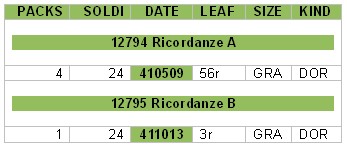
A particularly interesting trade is that of 13 October 1441: the cardmaker supplies a fine pack of naibi as part of a payment. This pack is of the finest quality made by him, as the four packs supplied a few months before; they are priced at 24s., higher than usual, but are naibi both Grandi and gilded. Probably, however, the most interesting indication for us about this special pack is its destination.
As a matter of fact, we learn not only that this pack passes directly from the painter to the silk-dealers, but also that they intend to send it to Venice, where evidently it could be sold, and probably in more favourable terms; this town was very active at the time as an international market, even of art products.
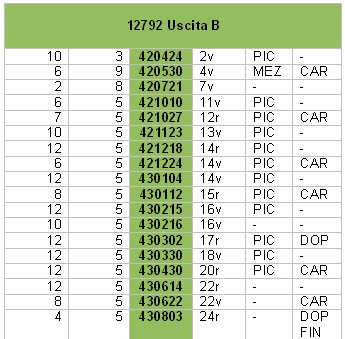
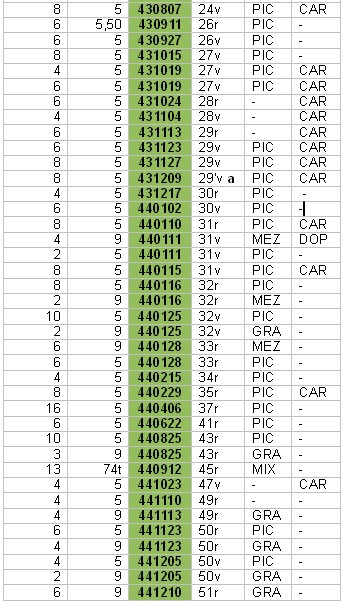
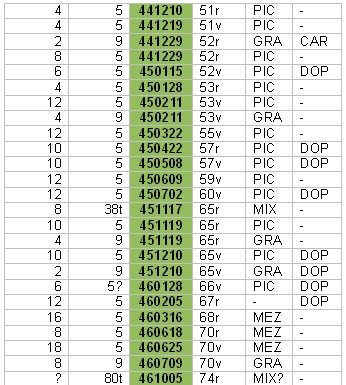
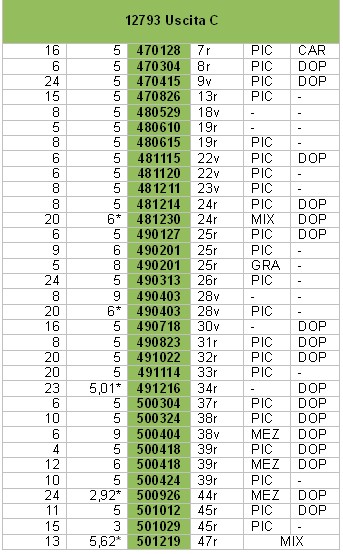
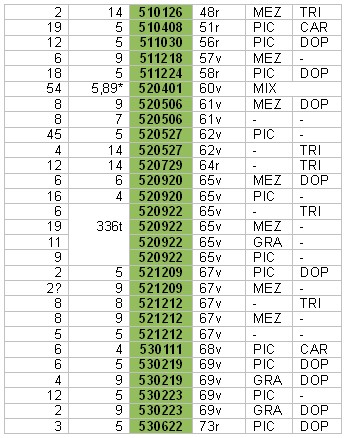

(a) There is a mistake in leaf numbering, with 29 present twice.
|
REPEATED TEXT: Abbreviations:
Franco Pratesi: "The abbreviations used should already be familiar to readers of the previous notes. As for size, they are GRA or grandi, large; MEZ mezzani, middle; MZL mezzanelli, the same as mezzani, or slightly different; PIC piccoli, small. As for kind, they are SCE or scempi, single; DOP doppi, double; DOR Dorati, gilded; CAR c(h)arte, cards; FIN fini, good quality; FOR di forma, made with woodblocks; RIM rimboccati, with folded edges; TRI trionfi. The abbreviation MIX, mixed, "di più ragioni", can involve both size and kind and clearly corresponds to the most uncertain values for the prices.
The date is in the format 14yymmdd. All the prices are reduced to soldi, (s.) changing into non-existent cents their fraction in denari (d.), one of which was 1/12 of 1s. (This explains the frequent appearance of N,67 or N,33 or similar approximate values.) An asterisk indicates that the price is an average value derived from the total amount recorded; it may be present for a single pack too, in case its price has been agreed upon.
There are several words that I am not sure to have read correctly and they are indicated as Name[?]."
Large text |
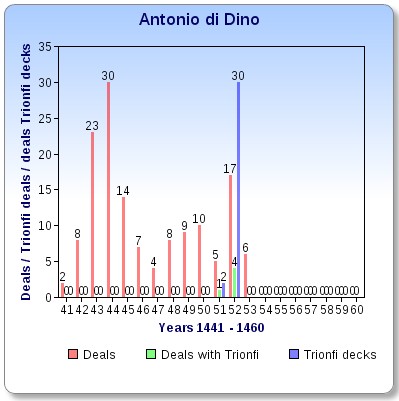
|
|
| SOURCE 2: Silk dealer sell decks
|
List of Playing Card Sales 1439 - 1454
(Silk trader Lorenzo di Bartolo and Matteo di Zanobi)
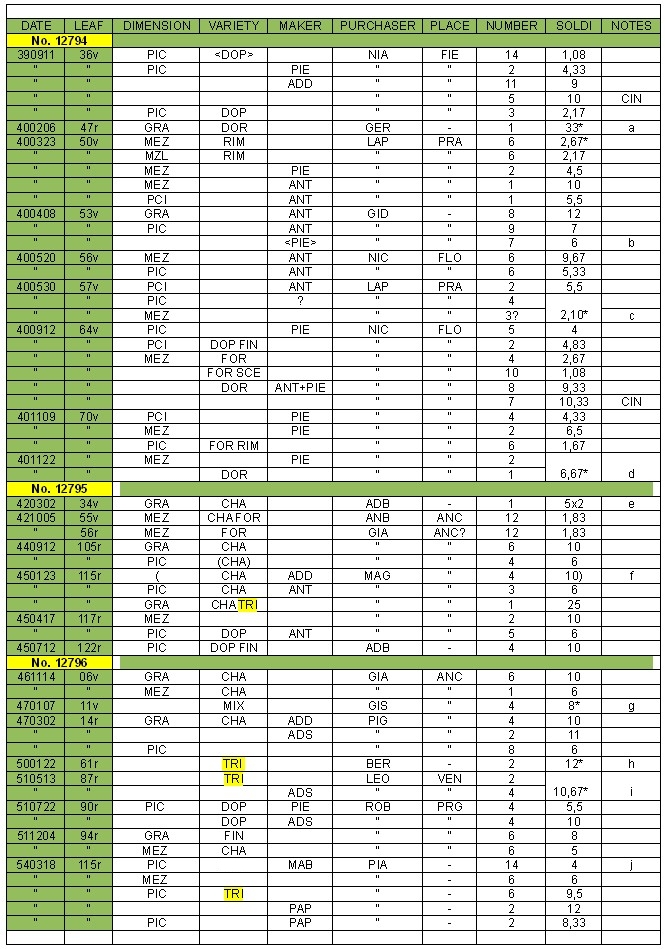
List of Abbreviations
(?) uncertain spelling of the previous word.
* price for single packs, deduced from the total price indicated as agreed upon.
<> the word inside can be read, but appears as deleted
ANC Ancona
ADB Antonio di Brunetto, see Purchasers
ADD Antonio di Dino, see Makers
ADS Antonio di Simone, see Makers
ANB Antonio di Beltramo, see Purchasers
ANT Antonio, see Makers
BER Bernardo, see Purchasers
CHA naibi recorded as charte
CIN Cinchaglie(?), see Makers
DOP doppi
DOR dorati, messi a oro
FIE fiera de la Vernia
FIN fini
FLO Florence
FOR a forma
GER Geradho di Paghole, see Purchasers
GIA Giannino d’Antonio, see Purchasers
GID Giovanni, see Purchasers
GIS Giannino di Simone, see Purchasers
GRA grandi
LAP Lapo, see Purchasers
LEO Leonardo, see Purchasers
MAB Matteo Ballerini, see Makers
MAG Martino di Giovanni, see Purchasers
MEZ mezzani
MIX more kinds together
MZL mezzanelli
NIA Nicholo di Nardo e Antonio di Iachopo merciai, see Purchasers
NIC Nicholao di Calvano, see Purchasers
PAP Paparello, see Makers
PCI piccini
PIA Pier Antonio di ser Barnaba, see Purchasers
PIC piccoli
PIE Piero, see Makers
PIG Piero di Giovanni, see Purchasers
PRA Prato
PRG Perugia
RIM rimboccati
ROB Ruberto di ser Bartolomeo, see Purchasers
SCE scempi
TRI trionfi
VEN Vinegia (Venice)
Notes and comments to the Tables
a - 1 pajo di najbi messi doro grandi per L.1s.13 dachordo.
b - 7 paia di najbi dj <pjero> piccjno per s.6 il paio.
c - 4 paja di najbj piccholi purghati(?) e 3 paja di najbj mezanj purghati(?) per s. quattordici d. otto tuttj.
d - In this case, the average price is for the 2+1 different packs.
e - The cost is twice the unitary price.
f - Apparently this entry has been corrected with the two following ones.
g - Charte di più ragioni, cards of several kinds, with total price agreed.
h - Trionfi da gugliare(?).
i - Dise per portare a Vinegia.
J - One reads 48s. a pair, but must be for a dozen.
|
| SOURCE 3: Lapini family sells decks
|
Naibi traded in 1453-1455
In the second book examined, we find a different and more familiar situation, corresponding to the middle of the 15th century. This is easier to compare with other account books already studied. However, there is something unusual in this book, which is thicker than similar ones, with more than three hundred leaves. It seems that the trade changed in the time of these records, with increasingly more entries concerning production rather than small trades of the shop. I have collected in the following Table all the packs that I could see in the book; namely, in its initial part.
* price for single packs, deduced from the total price and/or indicated as agreed upon.
Abbreviations
CAR Carte
DOP Doppi
GRA Grandi
MEZ Mezzani
PCI Piccini probably the same as Piccoli
TRI Trionfi
VAN Vantag(g)iati
Notes to the Table
1. Maker: Antonio di Dino.
2. Attribute added: begli, or fine.
3. Supplier: de la Lisa(?).
4. Purchaser: Agnolo d’Antonio, active in San Gimignano.
5. Supplier: Pagholo Corsellini, merciaio.
6. Attribute added: I could not read it.
| 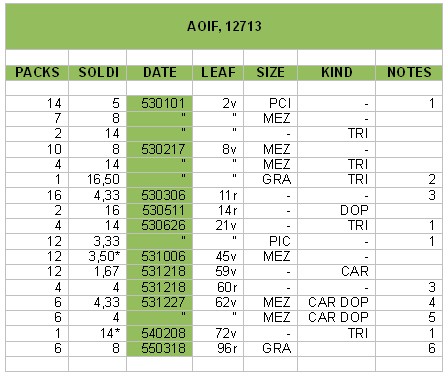 |
We can observe that low-quality packs still exist, but have rather become an exception among packs recorded here; only one dozen packs priced less than 2s. are present in the entries that I have seen in this store. Also at the other extreme we find a reduction of entries: the most expensive packs are a Naibi Doppi at 16s. and a Trionfi Grandi at 16s.6d. Other Naibi packs have prices in the middle range.
Interesting is also a case in which we see three Naibi packs acquired and sold on the same day, 27 December 1453: this immediately provides us with the information of the small mark-up adopted in this trade, less than 10%.
The appearance of Trionfi is remarkable; as it was easy to expect, they are priced higher than corresponding Naibi. However, we may note further details: apparently a price of 14s. had already become a standard price for them. These Trionfi seem generally to correspond to the Mezzani size, even though this is explicitly stated in just one occurrence; in the only one case in which we find the Grandi size indicated, the corresponding price only increases from 14s. to 16s.6d., still below that of several packs of Naibi Vantaggiati.
|
| SOURCE 4: A single Trionfi card trade in the year 1452
|
The article
"1452 – A DOZEN OF NAIBI DI TRIONFI"
by Franco Pratesi, 02.04.2012, notes Antonio di Dino as the cardmaker of 12 Trionfi decks at July 29 1452, but it adds no personal information to him.
| SOURCE 5: A not readable card producer name in the Puri family sales list 1447
|
The article
"1447-1449 - NAIBI ON SALE "
by Franco Pratesi, 27.01.2012, notes "One maker (an.o di do.o?) I have not been able to read." It is suspected, that this addressed again Antonio di Dino (here as a cardmaker, who produced 4 decks for the price of 5.5 Soldi each at a single event).
Repeated Note:
When Ross Caldwell and me in 2003 started to collect Trionfi notes between 1442-1463, we had about 27/28 entries (which I nowadays would count as 31). The major part were the documents of Ferrara, which were collected by Gherardo Ortalli and Adriano Franceschini in the "Prince and the Playing Cards" (1996), after the base laying works of Michael Dummett and Stuart Kaplan around 1980. This collection included 2 notes about Trionfi cards in Florence, found by Franco Pratesi in his earlier work (allowances of the Trionfi game in 1450 and 1463). A graphical representation of this time (with 27 entries) shows the dominance of Ferrarese documents (in black) with a few notes only from other locations (in red; see picture to the right)
In the period 2004 till October 2011 it was possible to add 4 further notes (Siena 1452, Padova 1455, Ancona c. 1460 and Valerio Marcello c. 1460), mainly thanks to information given by Thierry Depaulis.
Franco Pratesi started his new article series in November 2011. Since then the list has gotten 67 new documents till September 2012 (65 of them found by Franco Pratesi, one, now the oldest of September 1440, by Thierry Depaulis, and another one by Veber Gulinelli, who controlled the earlier work of Franceschini and found an overlooked document) and nearly all are related to Florence or its surrounding.
A small book (118 pages) was published around Christmas 2012, Franco Pratesi: "Playing Card Trade in 15th Century Florence" as IPCS Paper No. 7 (ISSN 0305-2133). It contains some of the articles, which before had appeared at this website, those, which treat the early time of 15th century. Thierry Depaulis commented in his foreword: "This book is a landmark in the history of early playing cards in Italy".
Well, maybe not the book, but the research is clearly a landmark in various interests. For the collection of early Trionfi notes it somehow means, that we have within the year 2012 about 200 % more data for the period 1440-1462 than mankind had collected in the 200 years before.
Added later:
In August 2013 the new report of Arnold und Doris Esch: "Aus der Frühgeschichte der Spielkarte. Der Import von carte da giocare und trionfi nach Rom." in Gutenberg Jahrbuch 2013, 88. Jahrgang, p. 41-53, arrived in our redaction. It contains 106 new references to Trionfi decks, which all were found in the customs registers of the city Rome for the period 1453-1465. With this the number of all earlier Trionfi cards records has been doubled and should have reached then c. 210 (from which a few are only considered to be "Trionfi card notes" and don't contain the word "Trionfi" or something similar).
***********
I'd started to sort the new Trionfi card documents overview in October 2012. Articles will be possibly changed according improvements in research.
|
Old Overview about Trionfi Card documents in 2003

Overview about Trionfi Card documents in 2013
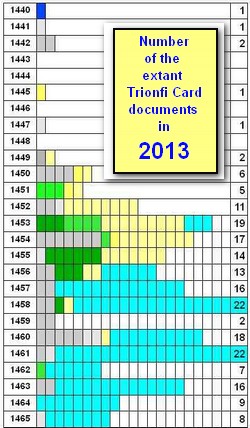 READ MORE
READ MORE
|
|












